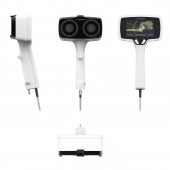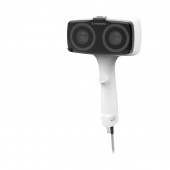Naviswiss Navigation Camera by Erdmann Design |
Home > Winners > #54053 |
 |
|
||||
| DESIGN DETAILS | |||||
| DESIGN NAME: Naviswiss PRIMARY FUNCTION: Navigation Camera INSPIRATION: We created a miniaturized handheld navigation unit which is used like a surgical instrument with similarly instantaneous results. The stamp-sized NAVItags add to the simplicity of the surgical process as they are easily cleanable and require only minimally invasive bone fixations. Small size and a simplified surgical process lead to important cost savings in both, acquisition and operation of the surgical navigation system. UNIQUE PROPERTIES / PROJECT DESCRIPTION: The Naviswiss system is an imagefree surgical navigation system which assists the orthopedic surgeon during the implantation of an artificial hip joint. It consists of a handheld navigation device which is used to register the patients anatomy. Subsequently the navigation system helps the surgeon to guide the surgical instruments with the goal to position the implant according to the preoperative planning. OPERATION / FLOW / INTERACTION: The Naviswiss system is used in hip surgery. It is used without CT images of the patient and is therefore easier in use than image based navigation systems. The surgeon fixes tags on the patients bones. During surgery the infrared stereo camera measures tag orientation and position and the system provides reference angle values for the implantation of the hip implant. The software guides the surgeon step by step through the workflow and provides guidance through instruction graphics and text. PROJECT DURATION AND LOCATION: The project started in November 2014 and finished December 2016 FITS BEST INTO CATEGORY: Medical Devices and Medical Equipment Design |
PRODUCTION / REALIZATION TECHNOLOGY: A first small series was done in PUR vacuum cast. SPECIFICATIONS / TECHNICAL PROPERTIES: Width 145mm x Depth 90mm x Height 240mm Weight approx 500g TAGS: human centered design, usability testing, experience design, interaction design, navigated hip surgery RESEARCH ABSTRACT: Most of the research was done in the field of optical tracking: The navigation unit includes an infrared stereo camera which measures the position and orientation of small NAVItags. An infrared flash illuminates the field of view to avoid available-light disturbance. An inertial measurement unit IMU is built-in which measures the camera orientation in space. CHALLENGE: Designing handheld devices is "Human Centered Design" in its purest form. The users instantly feel connected to the device when they take it in their hands. In order to accomplish the task of designing a suitable grip we heavily involved surgeons and nurses in numerous iteration loops. In addition to the hardware development we were also involved in the software interaction design. Major challenges were the reduced size of the screen and the goal to minimize the workflow steps. ADDED DATE: 2017-02-20 08:33:26 TEAM MEMBERS (2) : Peter Hess and Raimund Erdmann IMAGE CREDITS: Erdmann Design |
||||
| Visit the following page to learn more: http://naviswiss.eu/ | |||||
| AWARD DETAILS | |
 |
Naviswiss Navigation Camera by Erdmann Design is Winner in Medical Devices and Medical Equipment Design Category, 2016 - 2017.· Press Members: Login or Register to request an exclusive interview with Erdmann Design. · Click here to register inorder to view the profile and other works by Erdmann Design. |
| SOCIAL |
| + Add to Likes / Favorites | Send to My Email | Comment | Testimonials | View Press-Release | Press Kit |







